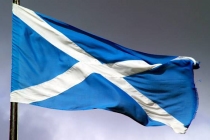Broch of Gurness in Orkney and the Accidental Discovery of an Icon of Orkney’s Rich Archaeological Heritage
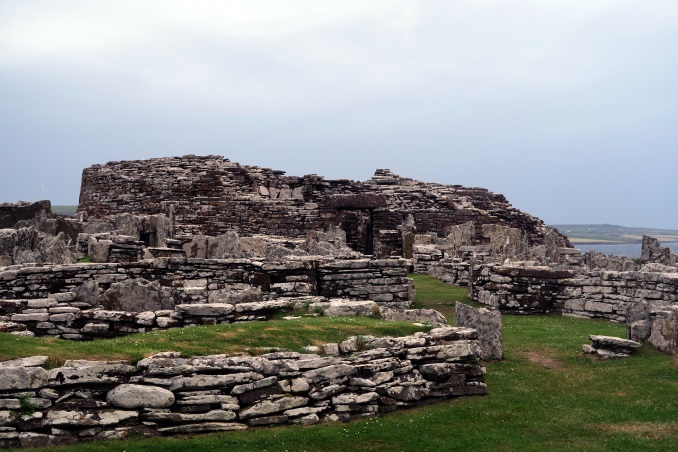
The Broch of Gurness is an outstanding surviving example of an Iron Age settlement that is unique to northern Scotland. However, for centuries it remained hidden under a large massive, grassy mound on the northeast coast of Mainland, the main island in Orkney, the group of islands situated off the north coast of Scotland. One day in 1929, Orcadian poet and antiquarian Robert Rendall (1898–1967), was sketching on the mound, which overlooks Eynhallow Sound and was known as the Knowe o' Aikerness. The leg of his stool sank into the ground and this prompted him to carefully remove some earth and stones which revealed the top of a staircase leading down into the mound.
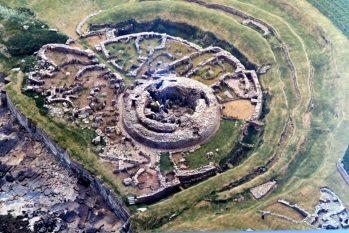
This accidental discovery lead to further excavations a year later and would eventually reveal the extent of this remarkable site. Around the broch, which is an Iron Age drystone hollow-walled structure of a type found only in Scotland, were the remains of a settlement estimated to have began sometime between 500 and 200 BC. The broch would have stood at around eight metres high (26 feet), with an internal diameter of 20 metres (65 feet). The remains of the central tower are now up to 3.6 metres (11.8 ft) high, and the stone walls are up to 4.1 metres (13.5 ft) thick. It is surrounded by a series of small stone dwellings housing a community of up to 40 families, enclosed in a large area of roughly of 45 metres (147ft) across enclosed by deep ditches and ramparts.
It is thought that the tower was inhabited by the principal family or clan but also served as a last resort for the village in case of an attack. A number of alterations appear to have been undertaken to the interior of the broch during its years of occupation, however, the original rectangular hearth and an underground chamber containing a spring-filled water tank can be seen today. The entrance to each of the surrounding dwellings led to a large living and sleeping room, off which were smaller side rooms. The main room had a hearth, a large tank set into the floor, cupboards and sleeping spaces. Some houses also had a yard, which was open to the sky, and a shed. Eynhallow Sound, the seaway between the Orkney mainland and the island of Rousay, would have been an important resource for the early inhabitants. There is evidence that cod, whale and seal were part of the diet, also providing skins and oil.
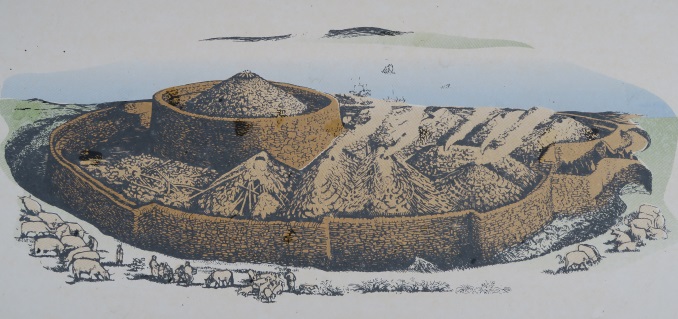
At some point after 100 AD the broch was abandoned and the ditches filled in. However, it is thought that settlement at the site continued into the 5th century AD, at a time when Orkney was part of the Pictish nation. By that time some of the stones were reused to build smaller dwellings on top of the earlier buildings. One of these houses, known today as the "Shamrock House", can still be seen. Typically Pictish in design, it was found buried in the rubble on the south-eastern part of the site and subsequently moved to the right of the modern entrance. Various Pictish objects found at Gurness include a Celtic ogham-inscribed bone knife handle and a stone carved with Pictish symbols. The fragmented remains of a Pictish carved symbol stone were also discovered on the nearby Sands of Evie. The last activity at the Gurness site appears to have have been in the 9th century. By which time it is likely that only a grass covered mound would have been visible at Gurness. Nevertheless, the mound could have held some significance in the belief system of the Norse settlers. A Viking woman was buried at the site in a stone-lined grave with two bronze brooches and a sickle and knife made from iron.
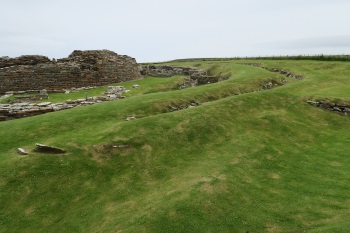
So, what was until the summer of 1929, a large grass covered mound, thanks to the accidental discovery by Robert Rendall. Turned out to be one of the most outstanding surviving examples of an Iron Age settlement in northern Scotland at Gurness. However, Orkney has a way of uncovering unexpected secrets. During the winter of 1850 a severe storm lashed the islands. Beneath the sand dunes on the Bay of Skaill on Mainland the combination of wind and very high tides stripped the grass from a large mound, then known as "Skerrabra" and also revealed a long hidden secret. One of the most remarkable archaeological sites in the world was discovered that year, when after many centuries nature lifted the cloak that had covered the 5000 year old preserved village at Skara Brae. Sometimes it seems that Orkney only reveals her secrets when she wants them to be found. One thing is for sure, there is more to come.
- Scottish
- English

